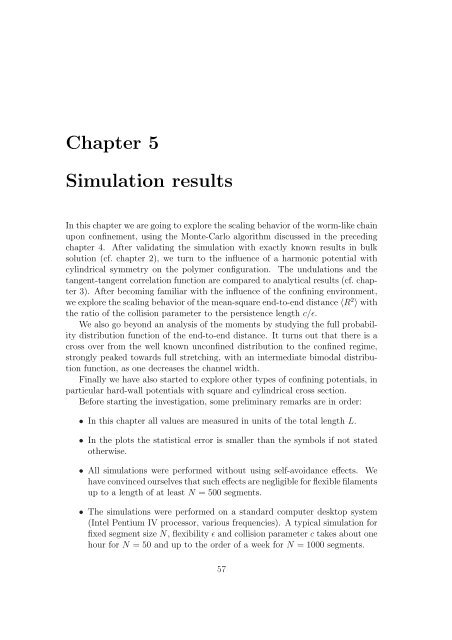Polymers in Confined Geometry.pdf
Polymers in Confined Geometry.pdf
Polymers in Confined Geometry.pdf
Create successful ePaper yourself
Turn your PDF publications into a flip-book with our unique Google optimized e-Paper software.
Chapter 5<br />
Simulation results<br />
In this chapter we are go<strong>in</strong>g to explore the scal<strong>in</strong>g behavior of the worm-like cha<strong>in</strong><br />
upon conf<strong>in</strong>ement, us<strong>in</strong>g the Monte-Carlo algorithm discussed <strong>in</strong> the preced<strong>in</strong>g<br />
chapter 4. After validat<strong>in</strong>g the simulation with exactly known results <strong>in</strong> bulk<br />
solution (cf. chapter 2), we turn to the <strong>in</strong>fluence of a harmonic potential with<br />
cyl<strong>in</strong>drical symmetry on the polymer configuration. The undulations and the<br />
tangent-tangent correlation function are compared to analytical results (cf. chapter<br />
3). After becom<strong>in</strong>g familiar with the <strong>in</strong>fluence of the conf<strong>in</strong><strong>in</strong>g environment,<br />
we explore the scal<strong>in</strong>g behavior of the mean-square end-to-end distance 〈R 2 〉 with<br />
the ratio of the collision parameter to the persistence length c/ɛ.<br />
We also go beyond an analysis of the moments by study<strong>in</strong>g the full probability<br />
distribution function of the end-to-end distance. It turns out that there is a<br />
cross over from the well known unconf<strong>in</strong>ed distribution to the conf<strong>in</strong>ed regime,<br />
strongly peaked towards full stretch<strong>in</strong>g, with an <strong>in</strong>termediate bimodal distribution<br />
function, as one decreases the channel width.<br />
F<strong>in</strong>ally we have also started to explore other types of conf<strong>in</strong><strong>in</strong>g potentials, <strong>in</strong><br />
particular hard-wall potentials with square and cyl<strong>in</strong>drical cross section.<br />
Before start<strong>in</strong>g the <strong>in</strong>vestigation, some prelim<strong>in</strong>ary remarks are <strong>in</strong> order:<br />
• In this chapter all values are measured <strong>in</strong> units of the total length L.<br />
• In the plots the statistical error is smaller than the symbols if not stated<br />
otherwise.<br />
• All simulations were performed without us<strong>in</strong>g self-avoidance effects. We<br />
have conv<strong>in</strong>ced ourselves that such effects are negligible for flexible filaments<br />
up to a length of at least N = 500 segments.<br />
• The simulations were performed on a standard computer desktop system<br />
(Intel Pentium IV processor, various frequencies). A typical simulation for<br />
fixed segment size N, flexibility ɛ and collision parameter c takes about one<br />
hour for N = 50 and up to the order of a week for N = 1000 segments.<br />
57













